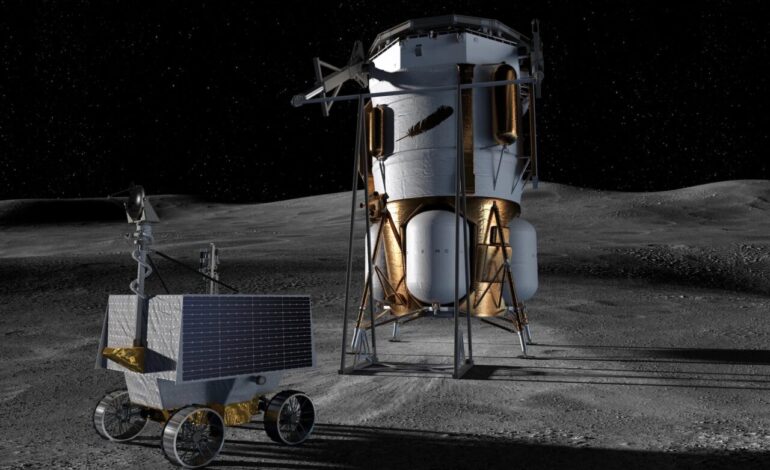Blue Origin Poised to Compete with SpaceX for NASA’s Artemis 3

NASA is reassessing its options for the lunar lander for the Artemis 3 mission, as delays with SpaceX’s Starship Human Landing System (HLS) raise concerns about meeting the scheduled timeline. With the potential for significant delays in SpaceX’s ability to deliver a crewed lunar lander by mid-2027, Blue Origin, led by entrepreneur Jeff Bezos, has emerged as a strong competitor to provide a viable lander sooner.
During a panel discussion at the American Astronautical Society’s 2025 von Braun Space Exploration Symposium, Jacqueline Cortese, Senior Director of Civil Space at Blue Origin, highlighted the company’s progress on its Blue Moon Mark 1 (MK1) and Mark 2 (MK2) landers. Cortese indicated that Blue Origin is aiming to launch an MK1 demonstration mission before the end of the year. The MK1 is designed to transport up to 3 tons of cargo to the lunar surface, serving as a precursor to the crewed MK2 lander, which could potentially replace SpaceX’s HLS for Artemis 3 if it is ready on time.
Cortese expressed optimism about Blue Origin’s approach, stating, “Especially with MK1 and some of our preceding work we’re doing, we have what we think are some good ideas about maybe a more incremental approach that could be taken advantage of for an acceleration-type scenario.”
SpaceX’s Challenges and Blue Origin’s Opportunities
SpaceX secured a $2.9 billion contract with NASA in 2021 for the Artemis program, but technical challenges have delayed the Starship HLS’s development. Experts are concerned that the lander may not be ready by the expected launch date, jeopardizing the U.S. goal of returning astronauts to the Moon. The complexities surrounding the Starship, the largest launch vehicle ever created, contribute to its delays. Astronauts would require an elevator system to descend to the lunar surface, complicating logistics.
In a recent interview, acting NASA Administrator Sean Duffy confirmed that the agency would consider alternative options for the Artemis 3 contract to ensure timely lunar exploration. Duffy stated, “I’m going to let other space companies compete with SpaceX, like Blue Origin, and again, whatever one can get us there first, to the Moon, we’re going to take.”
Blue Origin’s Path to the Moon
The design of Blue Origin’s lunar landers offers advantages over the Starship HLS. The MK1 and MK2 landers are based on a more straightforward concept and feature a lower center of gravity, which enhances stability during landing. These landers are being developed by a collaborative effort involving industry giants such as Lockheed Martin, Boeing, Draper, Astrobotic, and Honeybee Robotics.
NASA has already contracted Blue Origin to develop the MK2 for the Artemis 5 mission, which is scheduled for several years from now. Nevertheless, Cortese indicated that the MK2 could be fast-tracked for Artemis 3. The MK1 lander is currently undergoing final assembly at a dedicated production facility in Port Canaveral, Florida. Once completed, it will be transported to NASA’s Johnson Space Center in Houston, Texas, for testing in conditions that simulate the lunar environment.
The initial demonstration mission, named “Pathfinder,” aims to land near the Moon’s south pole. This mission will allow Blue Origin to evaluate essential systems and validate hardware intended for the MK2. It will also carry two NASA payloads: SCALPSS (Stereo Cameras for Lunar-Plume Surface Studies) and LRA (Laser Retroreflective Array). Cortese mentioned that the launch could occur within the next few weeks, although specific details remain unconfirmed.
If Blue Origin successfully launches the MK1 mission before 2026, it could significantly accelerate the timeline for the MK2 lander, as both share much of the same technology. Despite these advancements, Blue Origin faces considerable obstacles in preparing a crewed MK2 mission, including the need to demonstrate propellant transfer, validate the life-support system, and obtain crew certification.
As the situation unfolds, the focus is on SpaceX to deliver a functional lunar landing system ahead of mid-2027. The developments at Blue Origin could impact the competitive landscape, pushing SpaceX to expedite its efforts. Whether Blue Origin can truly leap ahead of SpaceX remains uncertain, but the race to the Moon is heating up.






